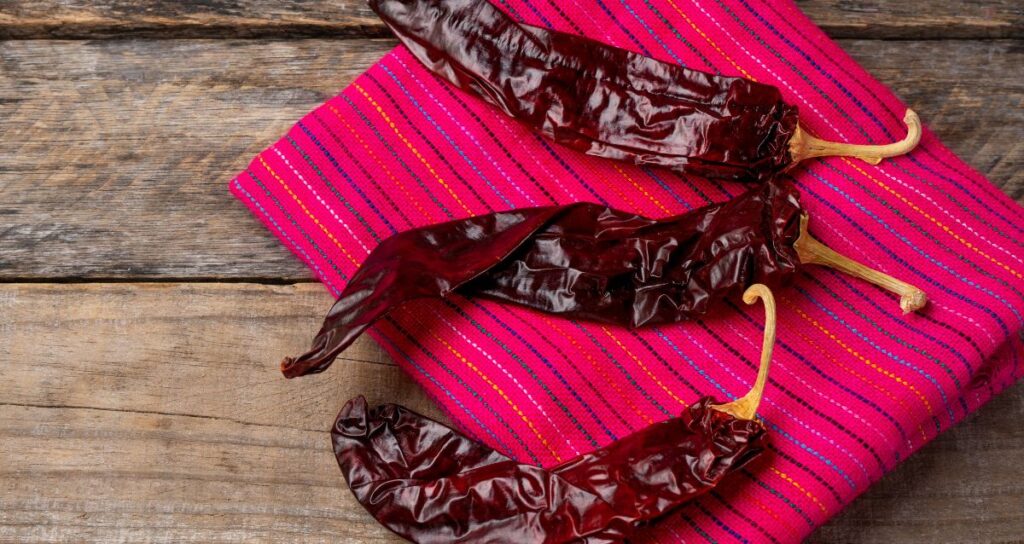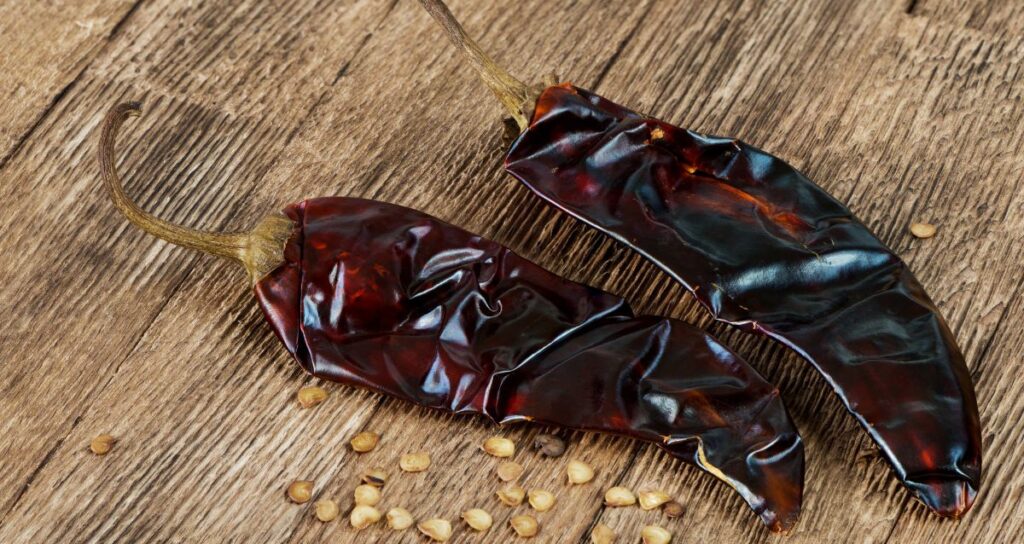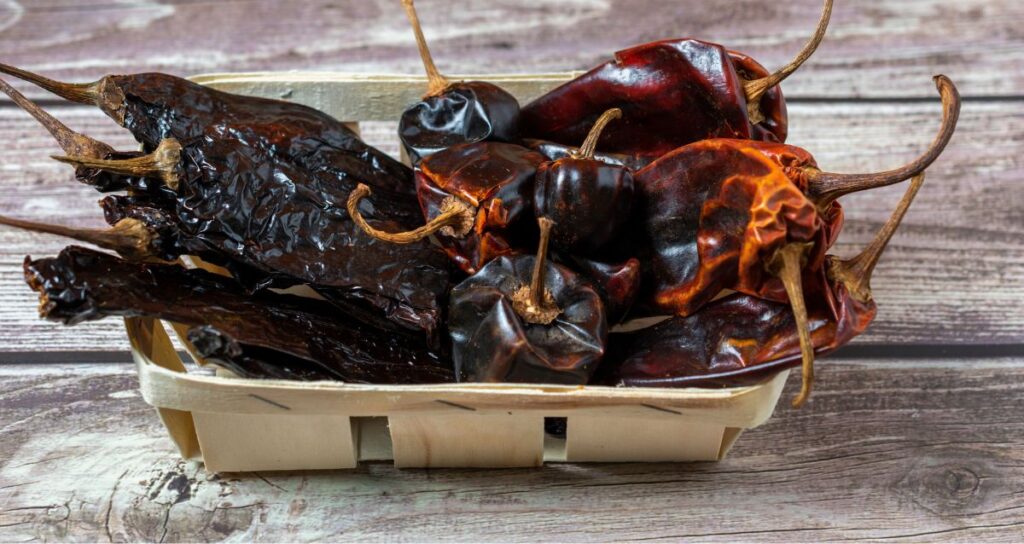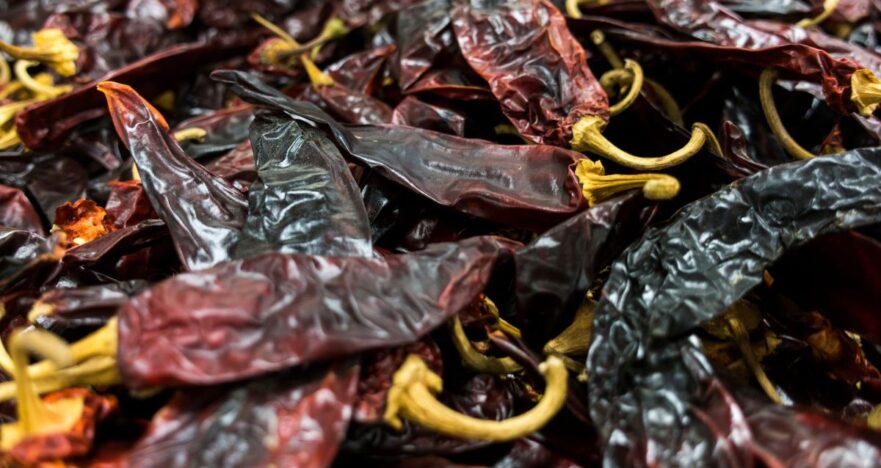In this article about guajillo:
🗺️ Origin and history | 🌶️ Uses | ✨ Appearance and taste | 🧑🌾 Growing – gardening | 👨🍳 Cooking – recipes | 🛒 Where to buy | 🫙 How to store | 👨⚕️ Health benefits | 🌶️ Alternatives and substitutes | ❓ Frequently asked questions
What is guajillo?
Guajillo peppers are chili pepper originating from Central America and Mexico, still used in traditional Mexican cuisine. The peppers are medium-sized and long, boasting a deep red hue when fully ripened. Guajillos are typically sold in dried form and are available in many grocery stores, especially those specializing in Mexican or Latin American foods.
With their mildly smoky yet fruity flavor, guajillo peppers offer a moderate heat level ranging from 2,500 to 5,000 Scoville heat units. Incorporation into Mexican cuisine yields many sauces, salsas, and stews, adding a distinct taste and vibrant color to the dishes.
| Guajillo pepper (Dried Mirasol pepper) | |
| SHU | 2,500 - 5,000 |
| Median SHU | 3,750 |
| Flavor | Sweet, fruity and smoky, with a mild to moderate heat |
| Species | Capsicum annuum |
| Origin | Central America and Mexico |
| Uses | Sauces, salsas, stews, soups, marinades, etc. |
Are guajillo peppers spicy? How hot are they?
Guajillo scoville: 2,500 to 5,000 SHU
The Scoville rating of guajillo peppers is from 2,500 to 5,000 units, which puts them in the mild to moderate heat scale. Guajillos offer much more heat than some other mild peppers, including bell peppers (Scoville rating of 0) and pepperoncini peppers (Scoville rating from 100 to 500 units). On the other side of the Scoville spectrum, jalapeños are often spicier than guajillos, with a Scoville rating of 2,500 to 8,000 units.
Many people enjoy a spicy kick from peppers, so for those who want more heat than guajillo peppers offer, there are many alternatives available. For example, serrano peppers will provide a spicier experience, with a Scoville rating ranging from 10,000 to 23,000 units. In addition, habanero peppers are even more intense, boasting Scoville ratings of 100,000 to 350,000 units. The good news is that whatever level of heat you prefer, there’s a perfect pepper for you to eat.
🗺️ ORIGIN AND HISTORY
Where do guajillo peppers come from?
Guajillo peppers, the dried form of mirasol peppers, are native to Mexico and Central America. Since their beginnings, they have been incorporated into Mexican cuisine. The guajillo pepper is predominantly produced in the Mexican state of Zacatecas; it is shared with other countries after cultivation and used in various dishes for centuries. The mirasol pepper turns into the guajillo pepper during the drying process, which intensifies its flavors and allows it to be stored for an extended period of time. With the aid of time, the guajillo pepper’s popularity has grown beyond Mexico’s borders. Today, they are utilized in diverse cuisines around the globe, as many enjoy adding their distinct flavor and moderate heat to their family-favorite meals.

🌶️ USES
What are guajillo peppers good for? How to use them?
Versatile and popular guajillo peppers, and in particular, dried guajillo chiles, are widely seen in their use in the culinary arts. Their unique flavor and mild to moderate spice make them a staple in traditional Mexican cuisine and increase their popularity as an ingredient used in fusion dishes. It’s important to note that “mirasol” refers to a fresh, raw pepper, while “guajillo” refers to the dried form of the mirasol pepper.
Dried guajillo peppers are included in many delicious sauces, such as mole, enchilada sauce, and guajillo chile BBQ sauce. Further, these sauces are regularly used as a base in various dishes, including stews, tacos, and grilled meats. To create these sauces, the guajillo chiles are rehydrated by soaking in hot water, then enduring a blending process with some extra ingredients, such as tomatoes, garlic, and spices. The sauces produce a rich, smoky, and slightly sweet taste, with mild heat from the guajillo chiles.
In addition to sauces, dried guajillo chiles are commonly used in soups, stews, and braises, adding an enhanced flavor and subtle heat. Another option is to grind them into a powder, then take the powder and use it as a rub or marinade for meat, poultry, or seafood. You must rehydrate the dried guajillo peppers before trying to incorporate them. Otherwise, the flavor will not be as prominent, and their texture will be harder to blend or grind.
Paired with other chiles, such as ancho and pasilla, guajillo peppers create diverse and multi-dimensional flavors in dishes. With their incorporation into recipes with different types of chiles, a unique and balanced heat and flavor is crafted, complementing a wide range of ingredients. Ultimately, whether guajillo peppers are simply a flavor enhancer on their own or combined with other chiles, they are a wonderful addition to your culinary repertoire.

✨ APPEARANCE AND TASTE
What do guajillo peppers look like?
A guajillo pepper is easily identified with its long, tapering shape and deep red color. Measuring 3 to 5 inches in length and 1 inch in width, typically, their size is average when compared to other peppers. Guajillo peppers have a smooth and glossy skin that often becomes wrinkled in places when dried. Their color can darken to a deeper red hue as they become dryer. With this diverse appearance, the guajillo pepper can be easily identified against other chili types, and its pleasing looks have only increased its popularity in cuisines.
What do guajillo peppers taste like?
As mentioned, guajillo peppers offer a mild to moderate spice level and often taste fruity, tangy, and smoky. They offer a subtle sweetness that blends well with the moderate heat, which lends to their diverse use in various dishes. The guajillo peppers are a typical ingredient that incorporates the warmth and a slight kick to numerous types of cuisine.
🧑🌾 GROWING – GARDENING
How to grow guajillo peppers?
Growing mirasol (guajillo) peppers is simple for home gardeners, a large benefit to their popularity. Warm temperatures and abundant sunshine help these peppers thrive, though they are often grown in many different climates.
When to pick guajillo peppers?
Recall that mirasol peppers become guajillo peppers when dried so that you will grow mirasol peppers in your home garden. They can be planted in the ground or grown in containers, generally reaching full maturity within 60-80 days of planting.
Mirasol peppers require well-draining soil and consistent watering to remain healthy and grow to their optimal state. Also, regular fertilization can benefit the peppers, especially during the active growing season. When the mirasol peppers are mature, they will show off a vibrant red color in appearance, a strong indicator that they are ready for harvesting. To capitalize on the healthy plants‘ growth, continue picking the mirasol peppers when they are ripe on a regular basis. Once harvested, the peppers can be dried to transform into guajillo peppers. Then, they can be stored for future use or immediately added to various culinary meals.
👨🍳 COOKING – RECIPES
Cooking / Recipe ideas for guajillo peppers
Guajillo peppers are a versatile ingredient in many types of dishes, such as sauces, soups, and main courses. One of the most popular ways to incorporate the peppers into a meal is to make a guajillo chile pepper sauce, often adding a kick of heat and subtly sweet flavor to favorite meals, including tacos or grilled meats.
Guajillo chiles are an essential ingredient in numerous Mexican dishes, like pozole and enchiladas. Pozole is a hearty stew that can combine guajillo peppers with hominy, meat (often pork or chicken), and multiple spices. Enchilada recipes call for sauces, and the guajillo pepper is often created into a rich sauce, then poured over the enchiladas and baked for a delicious result.
Additionally, the peppers are often made into guajillo chili beans and guajillo chile broth to demonstrate their unique flavor. The chili beans are usually simmered with a combination of guajillo peppers, tomatoes, onions, and spices, then offered as a side dish. The chile broth is made by simmering guajillo peppers with onions, garlic, and spices and is incorporated as a base for soups or even added into other recipes for a savory flavor.
A widely-known Mexican dish, tamales often feature guajillo peppers. These peppers are added to the filling for a small kick of heat and a yummy taste.
A couple of main courses that use the guajillo pepper are guajillo pepper chicken and guajillo pepper steak. The peppers are added into a marinade that enhances the natural taste of chicken or steak, whatever meat you select. By serving your guajillo-marinated chicken or steak with a side of the above-mentioned guajillo chili beans or a drizzle of guajillo chile pepper sauce will bring all of the flavors together in a complementary manner.
🛒 WHERE TO BUY
Where can I buy guajillo peppers?
Many places sell dried guajillo peppers. Grocery stores often carry them, especially the stores with a Hispanic or international foods section inside. In addition, specialty food stores or Latin markets more than likely will have guajillo peppers in stock. They can be purchased online from retailers that sell dried chiles and spices.
If you are shopping for guajillo peppers in person, be sure to locate the ones that are not too firm with a deep red color. Don’t purchase any that are discolored or stiff as they may be over-mature or possibly not stored correctly.
Where can I buy guajillo plants?
Guajillo plants can be purchased from online shops, as well as various garden centers or nurseries. When looking at the mirasol pepper plants, you will want to find those with sturdy stems and green leaves, as they will be among the healthier plants. Avoid plants that have wilted areas or discoloration in the leaves.
Where can I buy guajillo seeds?
And if you are interested in growing your own mirasol peppers at home to dehydrate and turn into guajillo peppers, seeds are often sold at garden centers, nurseries that specialize in vegetables, or via an online retailer. To start growing mirasol peppers as seeds, follow the instructions on the seed packet. Make sure to plant them where they will get lots of sunshine and have fertile soil that drains well.

🫙 HOW TO STORE
How do I store guajillo peppers?
Guajillo peppers are stored in a dried form, so they last longer on the shelf than fresh peppers. For proper storage, keep them in an airtight container or resealable plastic bag, then put them away in a cool, dry place, such as a pantry or cupboard. Taking advantage of the right storage conditions will help the peppers hold their flavor and keep them ready for use whenever you have a meal that calls for them.
For ground, powdered, or pasted forms of guajillo peppers, transfer them to an airtight container and store them in the refrigerator. The cool temperature will preserve its freshness and flavors, usually for up to several months. When using the ground pepper or paste as an ingredient, be sure to use a clean and dry spoon. Otherwise, your dried pepper will become wet or possibly contaminated.
❤️🩹 HEALTH BENEFITS
Are guajillo peppers healthy?
Guajillo peppers are rich in nutritional content, benefiting a range of health aspects. Low in calories and providing dietary fiber, they help to support healthy digestive systems and can even help with weight loss. With healthy amounts of vitamins A and C, guajillos can contribute to good eyesight, skin health, and strengthening the immune system.
Capsaicin has anti-inflammatory and analgesic properties and is also found in guajillo peppers. Capsaicin shares a relationship with the promotion of faster metabolism and support in weight loss. Some people experience digestive discomfort after eating spicy foods, including mild or moderately-spicy guajillo peppers. For those, avoiding or reducing your consumption of these peppers is recommended.
🔄 ALTERNATIVES AND SUBSTITUTES
What’s a good alternative for guajillo peppers?
There is a vast amount of peppers available aside from the guajillo pepper, so that a good substitute will depend on your heat and flavor preferences, ultimately. One of the most similar options is the Ancho pepper, sharing a similar sweet and savory taste, though a bit milder in heat levels. The Ancho pepper is often added to sauces and stews for its flavoring while the heat level tapers off.
You could try pasilla peppers to experience a hotter and different flavor (with hints of raisin, berries, and cocoa). Pasilla peppers are great in recipes that use guajillo peppers if you can’t find them because their flavor combines well with other chiles for a dynamic taste.
Substituting guajillo peppers with New Mexico chiles is another good idea, as they hold a similar heat and flavor. These chiles, both dried and fresh, give them similar flexibility for usage in food selections.
A final substitute is California chile, and though milder in heat, it has a similar fruity, slightly sweet taste. California chile is a good choice for those who wish to avoid spiciness. It offers its flavor without much heat and is easy to use in a wide range of meals, including sauces and stews.
How do you pronounce guajillo?
Guajillo pepper is pronounced as gwah-HEE-yoh.
🙋 FREQUENTLY ASKED QUESTIONS
FAQ about guajillo peppers
Is guajillo pepper spicy?
Guajillo peppers range from 2,500 to 5,000 units on the Scoville heat rating. This puts them at a mild to moderate heat level. While the kick is there, these peppers are not overly hot, so many enjoy the mild spice tasted in meals. Guajillo peppers taste smoky, tangy, and fruity, so their flavor enhances and draws out similar ingredients without overpowering a dish. Commonly used in Mexican meals, including sauces, stews, and soups, these peppers are known to be mildly hot, flavorful, and not overly intense.
How to dry guajillo peppers?
Air drying, oven drying, or using a dehydrator will result in dry guajillo peppers. To air dry the mirasol peppers, clean their skins, remove the stems, and place them on a wire rack in a single layer, then place the rack in an open, well-ventilated area away from sunlight. Flip each pepper over daily. The drying process can take up to three weeks, so remain patient! For oven drying, preheat your oven to 150°F (65°C), arrange the clean mirasol peppers on a baking sheet, then place in the oven with the door slightly ajar. Every hour, you will need to check on the peppers and flip them over once. The drying process will take between 4 to 8 hours. Finally, when using a dehydrator, follow the manufacturer's instructions. The temperature generally will be set between 125°F to 135°F (52°C to 57°C), then the cleaned mirasol peppers will be set on their trays. Drying time with this method ranges from 8 to 12 hours.
Is guajillo hotter than jalapeño?
The heat level of guajillo peppers sometimes overlaps with jalapeño peppers, though typically, guajillos are milder than jalapeños. Jalapeño peppers have a Scoville rating of 2,500 to 8,000 units. They rank higher than guajillos, so they are most likely hotter than an average guajillo pepper.
Is guajillo hotter than Chipotle?
Similarly to jalepeño peppers, guajillo peppers are milder than chipotle peppers most of the time. Chipotle peppers are simply smoked and dried jalapeños, so they retain the same Scoville rating of 2,500 to 8,000 units.
Which dried chiles are the hottest?
Dried forms of peppers are incredibly popular, though some are spicier than others. The Carolina Reaper is well-known as the world's hottest pepper, with a Scoville rating of 1,400,000 to 2,200,000 units. In second place is the Trinidad Moruga Scorpion, with a rating between 1,200,000 to 2,000,000 units. Third comes to the ghost pepper (Bhut Jolokia) at 855,000 to 1,041,427 units. A couple of other noteworthy spicy dried chiles include habanero and Scotch Bonnet, whose Scoville ratings range from 100,000 to 350,000 units. Please note that all Scoville values are approximations and vary based on additional factors.
What's the difference between a guajillo and an ancho?
Both guajillo and ancho peppers are dried, though they are different in flavors, heat levels, and appearance. Guajillo peppers are thin and have a shiny, deep red color. They taste fruity and slightly smoky with a mild to moderate heat level. Ancho peppers are dried poblano peppers, broader in size with a deep red to brown color, unlike the vibrant red of the guajillo. Their heat level is mild, and while their flavor is also slightly smoky, they are rich and sweet as well.
